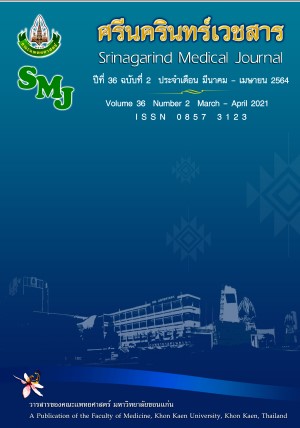Factors Affecting Abnormal CT Scan in Mild Traumatic Brain Injury – High-Risk Patients
Keywords:
head injury; traumatic brain injury; cerebral concussion; intracranial hemorrhageAbstract
Background and Objective: Traumatic brain injury is one of the most significant problems worldwide. Major causes of head injury are caused by traffic accidents and fallings. In mild traumatic brain injury, consider that there are risk factors for abnormalities in the brain. However, there is a lack of study in risk factors for neurosurgical intervention related to abnormal CT findings in Thai people.
Method: Retrospective descriptive study in the patients diagnosed mild traumatic injury (GCS 13-15), with high risk for abnormalities in CT scan. The outcome of the study is to admeasure the ratio of abnormal CT findings and to determine factors that affected abnormal CT findings.
Results: There were 117 mild traumatic brain injury – high-risk patients performed a CT scan. Of those, 41 patients (35%) had abnormal CT findings. Two significant factors affecting abnormal CT findings; GCS 13-14 after observation and signs of open/base of skull fractures with a number of 5 (p£0.011) and 5 (p=0.037), respectively.
Conclusion: Open skull or base of skull fracture and GCS of 13-14 observation were the most two strongest predictors for abnormal CT scan in mild traumatic brain injury – high-risk patients.
References
2. Bruns J, Jr., Hauser WA. The epidemiology of traumatic brain injury: a review. Epilepsia. 2003; 44 (Suppl 10): 2-10.
3. Global status report on road safety 2018. World Health Organization; 2018. ISBN: 9789241565684. CC BY-NC-SA 3.0 IGO
4. สุรกรานต์ ยุทธเกษมสันต์. เอกสารเผยแพร่ในคณะทำงานจัดทำแนวเวชปฏิบัติกรณีบาดเจ็บที่ศีรษะ. สถาบันประสาทวิทยา, กรุงเทพมหานคร; พฤศจิกายน 2561.
5. Andelic N, Sigurdardottir S, Brunborg C, Roe C. Incidence of hospital-treated traumatic brain injury in the Oslo population. Neuroepidemiology 2008; 30(2): 120-128.
6. Masson F, Thicoipe M, Aye P, Mokni T, Senjean P, Schmitt V, et al. Epidemiology of severe brain injuries: a prospective population-based study. J Trauma2001; 51(3): 481-489.
7. Wu X, Hu J, Zhuo L, Fu C, Hui G, Wang Y, et al. Epidemiology of traumatic brain injury in eastern China, 2004: a prospective large case study. J Trauma 2008; 64(5): 1313-1319.
8. Agrawal A, Galwankar S, Kapil V, Coronado V, Basavaraju SV, McGuire LC, et al. Epidemiology and clinical characteristics of traumatic brain injuries in a rural setting in Maharashtra, India. 2007-2009. Int J Crit Illn Inj Sci2012; 2(3): 167-171.
9. Menon DK, Schwab K, Wright DW, Maas AI, Demographics, Clinical Assessment Working Group of the I, et al. Position statement: definition of traumatic brain injury. Arch Phys Med Rehabil 2010; 91(11): 1637-1640.
10. Haydel MJ, Preston CA, Mills TJ, Luber S, Blaudeau E, DeBlieux PM. Indications for computed tomography in patients with minor head injury. N Engl J Med 2000; 343(2): 100-5.
11. Stiell IG, Wells GA, Vandemheen K, Clement C, Lesiuk H, Laupacis A, et al. The Canadian CT Head Rule for patients with minor head injury. Lancet 2001; 357(9266): 1391-6.
12. Wayne WD. Biostatistics: A foundation of analysis in the health sciences (6th ed.). John Wiley&Sons, Inc.; 1998: 180.
13. Ngamjarus C, Chongsuvivatwong V. n4Studies: Sample size and power calculations for iOS. The Royal Golden Jubilee Ph.D. Program - The Thailand Research Fund&Prince of Songkla University; 2014.
14. Mahdi Sharif-Alhoseini, Hossein Khodadadi, Mojtaba Chardoli, Vafa Rahimi-Movaghar. Indications for brain computed tomography scan after minor head injury. J Emerg Trauma Shock 2011; 4(4): 472–476.
15. Albers CE, von Allmen M, Evangelopoulos DS, Zisakis AK, Zimmermann H, Exadaktylos AK. What is the incidence of intracranial bleeding in patients with mild traumatic brain injury? A retrospective study in 3088 Canadian CT head rule patients. Biomed Res Int 2013; 2013: 453978. doi: 10.1155/2013/453978. Epub 2013 Jul 15.
16. Mishra RK, Munivenkatappa A, Prathyusha V, Shukla DP, Devi BI. Clinical predictors of abnormal head computed tomography scan in patients who are conscious after head injury. J Neurosci Rural Pract 2017; 8(1): 64-67. doi: 10.4103/0976-3147.193538.




